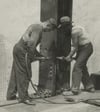
Part 2 of our series on how to get a great coating. Don't worry this is the end of our story, it's not a Star Wars saga. You followed our insightful instructions in part one of our story and sent in your parts for one of our inert, corrosion resistant or fouling resistant products. After 4 days you get an email letting you know that your order is ready to ship. 4 days, wow that's fast! Yes our manufacturing operations now average about 3.5 days to process your parts. Fantastic you say, but now what do I do? My parts are on their way back to me and I'm a bit clueless about what to do next. What should I expect from the coating, do I need to do anything special to the parts? Here are 5 tips for assuring a happy homecoming and productive future for your coated parts without the shock, like kitty here...
1. When you receive your order open the box and empty it completely

Wow that's some deep advice.... Of course I'll open the box you say... But in some situations that may not be the case. Company receiving departments can forward your order without inspection, depending on internal policy. The unopened box lands on your desk just at the wrong time, you're knee deep in a crisis so the box is set aside for a minute. Minutes turn to days or weeks; finally when you get around to opening the box you find a problem. Things happen, parts can get damaged in shipping, sometimes small parts can be misplaced. It's a lot easier to track down a problem sooner than later so do yourself a favor and open the box and inspect your parts thoroughly as soon as the box hits your desk.
Why empty the box? Because small parts can work their way to the bottom of the box. I can't tell you how often we get calls about incomplete orders only to find the parts were actually still in the box hidden by the packing material. We take pictures of parts before and after coating partly to have a record of what parts were in the box and to assure they looked great prior to shipping. If you need help confirming an order, give us a call and we'll be happy to forward our photos.
2. Corral your parts

Be sure to reunite all fitting, valve or other subassembly components to be sure all parts are there. You may have held back parts that aren't typically coated like ferrules or nuts. Pull them off the shelf and group all components and review manufacturer assembly instructions or review photos taken during disassembly. (Assuming you remembered to document the disassembly process). Serialized components should be grouped and accounted for. Remember to tell us if parts require serial number control prior to shipping to us for treatment.
3. Confirm parts are in ship shape
Inspect coated parts to be sure they meet your expectations. SilcoTek® goes the extra mile to provide Plus 1 service and quality. We thoroughly inspect all parts prior to shipping, but on occasion, a part may not meet your expectations. So check parts to assure surface appearance and overall quality meet your specifications. On occasion you may discover a fine "dust" or particulate on the surface. That's excess silicon from our process. We remove excess silicon during processing but some trace "dust" may remain. Upon arrival, coated parts should be clean and have a luminescent shine, but don't assume the parts meet your cleaning specifications which may be more rigorous than our standard process cleaning. If you have specific cleaning requirements, please forward cleaning specifications or handling specifications to us before sending parts to us for treatment.
4. Getting it all together

Assembling SilcoTek treated components should be no different than assembling uncoated parts. Our surfaces are thin, typically a fraction of a micron thick, so part interference should not be an issue. If you have high precision components, discuss tolerances with our technical service staff before sending parts in for treatment.
Galling can be a concern when assembling 2 parts made of similar material. When assembling SilcoTek® treated threaded components use PTFE, or anti-seize compounds made from silver, moly or nickel. Read more about galling in our Recommended Care Guide.
Our products are highly durable but you don't want to be too aggressive with handling, wrenching, or hammering on coated parts. If handling and assembly methods could scratch or dent stainless steel, it most likely will damage the surface. (Our surface is about as durable as stainless steel).
5. Keeping your coating happy
Congratulations, you've now got a coated part performing flawlessly in your process. You can expect exceptional performance from your parts for years to come, but ultimately the performance will depend on the environment. A severely corrosive environment, abrasion, rough handling or other environmental factors will impact long term performance. Keeping your parts running at peak performance is easy. Be sure to clean surfaces regularly, contaminants can be adsorptive while particulates can damage the surface and avoid steam cleaning parts. Want a quick care reference?Here's a coating care guide to help you keep the surface running at peak condition.






